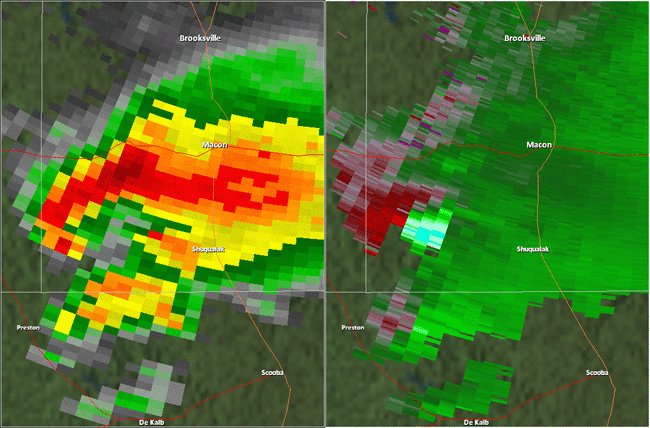The El Reno tornado (2013) was, in the official records, downgraded from EF-5 to EF-3 on the basis that EF-5 damage was not found and “the Enhanced Fujita scale is a damage scale” (quotation my own). Let me go on record right now as saying that I oppose this and all other instances where scientifically collected, calibrated wind speed data are ignored. I oppose the practice of rating tornadoes based strictly on those factors that civil engineers deem important while throwing out data collected by meteorologists, and for several reasons.
- Estimates of wind speed that are derived ex post facto from damage are inherently less reliable than objective, instrumentally collected measurements. This should not even be controversial. Differences in materials, building practices (which can be very hard to determine in the event of total obliteration), and even environmental factors (e.g., temperature and humidity) prior to a tornado can affect at what wind speed the structure fails. Surveys attempt to find out about such things, but it’s inherently impossible to cover all bases. Measurements are always more reliable than estimates, even educated ones.
- The Enhanced Fujita scale was designed to be expanded. In practice, vehicular and ground damage are now included as damage indicators in surveys, even though the official EF scale documents don’t (to my knowledge) list them. There was also the intention, when the scale was formed, of leaving it open for actual wind data to be used in ratings.
- The Enhanced Fujita scale is a wind scale. It is not just a way of rating the intensity of damage, which need not have anything to do with wind at all. The EF scale is not used for rating damage caused by floods, hailstorms, or earthquakes; it is used for tornadoes, which are wind events. Tornado surveys do not merely say that a tornado “has produced EF-3 damage.” They also assign an estimated numerical wind speed to the storm. This is apparently a subtle point for those who insist that the EF scale is a “damage scale,” but I really don’t think it’s all that hard to understand once you think about it. Saying that the EF scale is a damage scale is like saying that, traditionally, the Celsius scale was a mercury expansion scale, not a temperature scale, because mercury thermometers were used to determine temperature. That would obviously be ridiculous. The EF scale is a wind scale. Primarily it uses damage for the determination of wind speeds, but only because measurement data are not usually gathered. That unfortunate circumstance is no reason to throw out valid data when they are available.
- Portable Doppler wind measurements can, in fact, be extrapolated to the surface in tornadoes. The wind speeds near the ground level (i.e., damage level) of a tornado are likely to either match or even exceed those found at heights measured by portable Doppler radar (Wurman et al, Bulletin of the AMS, June 2013). Though the researchers cited didn’t measure a tornado with winds this high, the research implies that, yes, 300 mph winds could occur at the surface if they were measured at portable Doppler level. The cited research is another reason why I have gotten off the fence and decided that 320 mph or higher winds could also theoretically occur at the surface in subvortices of the most violent tornadoes, such as, perhaps, the Hackleburg, AL tornado of 4/27/2011.
It is becoming increasingly clear to meteorologists that, although the categories of the EF scale are probably accurate as regards the intensity of wind required to damage structures in specific ways, the scale is grossly inadequate for measuring the highest possible winds that a tornado could produce. There is little question that the most powerful EF-5 tornadoes can generate winds well in excess of 200-210 mph at the surface, especially if they are multivortex. Surface winds of 300 mph in subvortices are also a near-definite, and there is quite a difference between 210 and 310 mph. The former will reduce a well-built house to its foundation but could be survivable; there are accounts of people who sat through Category 5 hurricanes, which could generate wind gusts of that intensity. The latter will shred the debris into pellets and tear the human body to pieces (see, for example, the Jarrell, TX tornado of 1997, but get your Pepto and smelling salts if you read detailed accounts of that). The former could be ridden out in an above-ground shelter (the kind of shelter, incidentally, that some non-meteorologists involved in the creation of the EF scale had a financial stake in selling—just saying). The latter requires an in-ground storm cellar with guard rails to hold. I regard it as, frankly, grossly irresponsible for the public not to be informed of the true intensity that EF-5 tornadoes can reach or what such incredible winds can do.
I don’t blame the meteorologists at Norman for what happened. They wanted to use hard data in the rating of the El Reno tornado, obviously. There must have been pressure exerted from some other source. I do hope, however, that weather scientists are soon able to force an official change in the procedure of rating tornadoes when calibrated, scientifically valid wind data are available. One way to bring this change about more quickly is to increase funding for university meteorology departments so that they can send out chase teams equipped with portable Doppler. Disregarding one or two sets of data, all from one small region, can apparently be done by the “powers that be.” Disregarding data from all over Tornado Alley might not be doable.


